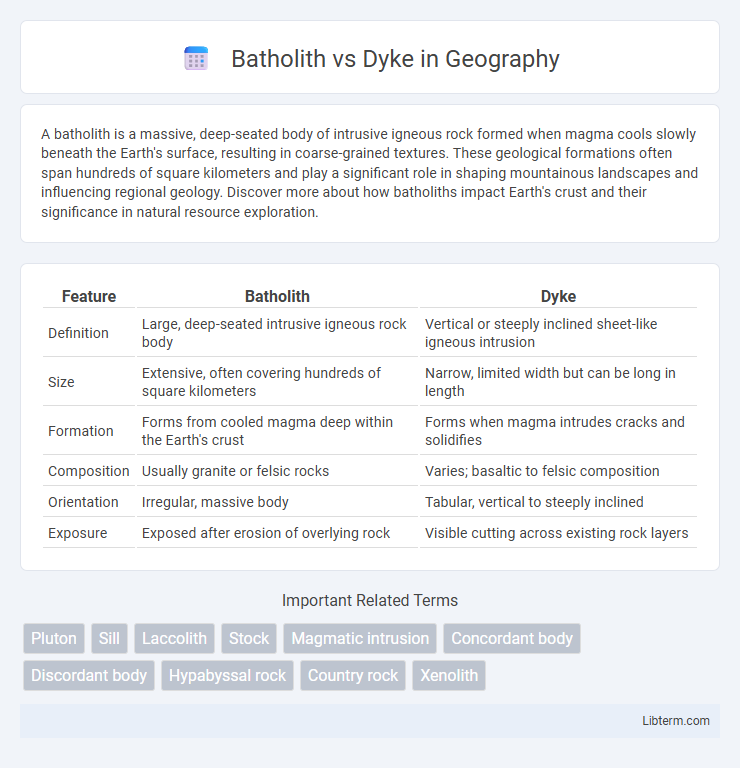A batholith is a massive, deep-seated body of intrusive igneous rock formed when magma cools slowly beneath the Earth's surface, resulting in coarse-grained textures. These geological formations often span hundreds of square kilometers and play a significant role in shaping mountainous landscapes and influencing regional geology. Discover more about how batholiths impact Earth's crust and their significance in natural resource exploration.
Table of Comparison
| Feature | Batholith | Dyke |
|---|---|---|
| Definition | Large, deep-seated intrusive igneous rock body | Vertical or steeply inclined sheet-like igneous intrusion |
| Size | Extensive, often covering hundreds of square kilometers | Narrow, limited width but can be long in length |
| Formation | Forms from cooled magma deep within the Earth's crust | Forms when magma intrudes cracks and solidifies |
| Composition | Usually granite or felsic rocks | Varies; basaltic to felsic composition |
| Orientation | Irregular, massive body | Tabular, vertical to steeply inclined |
| Exposure | Exposed after erosion of overlying rock | Visible cutting across existing rock layers |
Introduction to Batholiths and Dykes
Batholiths are large, coarse-grained igneous rock bodies that form deep within the Earth's crust from cooled magma, often covering hundreds of square kilometers. Dykes are narrow, tabular igneous intrusions that cut across pre-existing rock layers, solidifying from magma that fills fractures or cracks. Both structures provide crucial information about the geological history and magmatic processes beneath the Earth's surface.
Defining Batholiths: Characteristics and Formation
Batholiths are massive, coarse-grained intrusive igneous rock bodies formed deep within the Earth's crust, typically composed of granite or granodiorite, and cover areas greater than 100 square kilometers. They crystallize from slowly cooled magma over millions of years, resulting in large, irregularly shaped bodies that serve as the core of many mountain ranges. Batholiths differ from dykes, which are smaller, sheet-like intrusions that cut across existing rock layers.
Dykes Explained: Structure and Composition
Dykes are vertical or steeply inclined sheets of igneous rock that cut through pre-existing formations, forming when magma intrudes into fractures and solidifies. Their composition typically varies from basaltic to granitic, reflecting the chemistry of the magma source, and they often display fine-grained textures due to rapid cooling. Unlike batholiths, which are large, deep-seated plutonic bodies, dykes are relatively narrow and can extend for several kilometers, serving as key indicators of ancient volcanic plumbing systems.
Geological Processes Behind Batholiths
Batholiths form deep within the Earth's crust through the slow cooling and solidification of large magma chambers, resulting in massive, coarse-grained intrusive igneous rock bodies often covering hundreds of square kilometers. These plutonic formations arise from tectonic processes such as subduction, where magma generated by melting of the mantle and crust accumulates and crystallizes at considerable depths. In contrast, dykes are relatively thin, sheet-like intrusions that cut across existing rock layers, forming when magma exploits fractures during rapid ascent toward the surface.
How Dykes are Formed: Origins and Mechanisms
Dykes are formed when magma intrudes into pre-existing fractures or cracks within the Earth's crust, solidifying as vertical or steeply inclined sheets of igneous rock. These formations occur due to tectonic stresses that create pathways for magma to ascend from deeper magma chambers or mantle sources. The rapid cooling and crystallization within these narrow fissures lead to the distinct, often planar geometry of dykes, distinguishing them from larger, more massive batholith intrusions.
Key Differences Between Batholiths and Dykes
Batholiths are massive, irregularly shaped intrusive igneous rock bodies that form deep underground and often cover hundreds of square kilometers, while dykes are relatively thin, planar intrusions that cut across pre-existing rock layers vertically or steeply. Batholiths cool slowly over millions of years, resulting in coarse-grained textures like granite, whereas dykes cool more quickly, producing finer-grained or glassy textures. The scale and formation environment distinguish batholiths as large plutonic features and dykes as smaller, discordant intrusions.
Similarities in Magmatic Intrusions
Batholiths and dykes both represent forms of magmatic intrusions where molten rock from the mantle solidifies beneath the Earth's surface. They share similarities in their origin from magma that cools and crystallizes, creating igneous rock formations. Both structures provide valuable insights into the geological processes and magma dynamics occurring within the Earth's crust.
Examples of Famous Batholiths and Dykes
The Sierra Nevada Batholith in California exemplifies a massive granitic formation formed deep within the Earth's crust, while the Palisades Sill along the Hudson River is a notable example of a prominent dyke composed of diabase. The Coast Range Batholith in British Columbia showcases extensive intrusive igneous rocks, contrasting with the Ferrar Dolerite dykes found in Antarctica, which are part of a widespread dyke swarm. These examples highlight the difference in scale and formation between vast batholiths and relatively narrow dykes cutting through surrounding rock layers.
Geological Importance of Batholiths and Dykes
Batholiths are massive, deep-seated intrusive igneous bodies that play a crucial role in shaping continental crust by indicating prolonged magmatic activity and crustal growth. Dykes are vertical or steeply-inclined sheets of igneous rock that serve as pathways for magma ascent, revealing information about tectonic stress fields and magmatic plumbing systems. Understanding batholiths aids in reconstructing the evolution of mountain belts, while dykes provide insights into crustal fractures and the dynamics of volcanic systems.
Batholiths vs Dykes: Implications for Earth’s Crust
Batholiths and dykes represent contrasting igneous intrusions with significant implications for Earth's crustal structure and evolution. Batholiths are massive, coarse-grained plutons formed deep underground, often exceeding 100 square kilometers, that contribute to crustal thickening and tectonic stability. Dykes are smaller, tabular intrusions that cut through existing rock layers, facilitating magma transport and influencing crustal fracturing and stress regime changes.
Batholith Infographic

 libterm.com
libterm.com